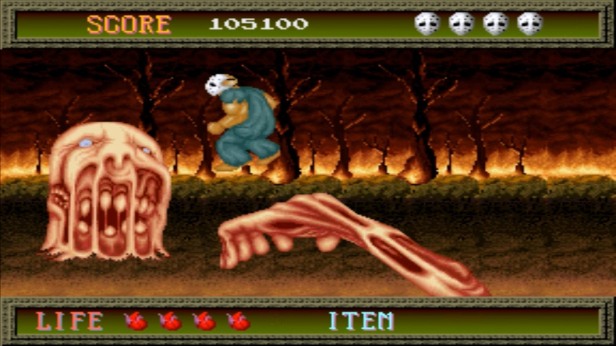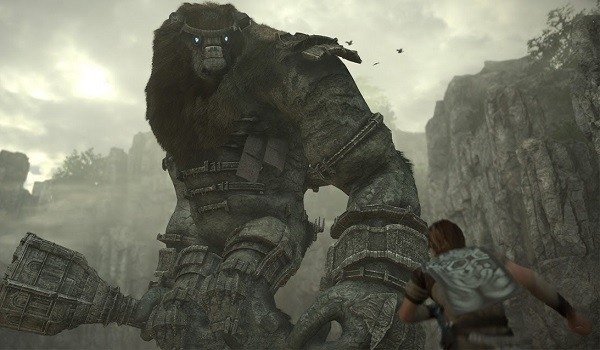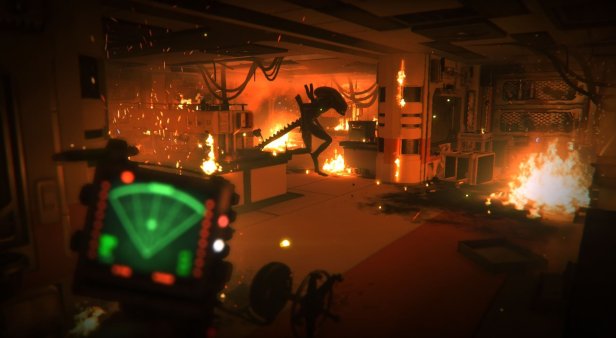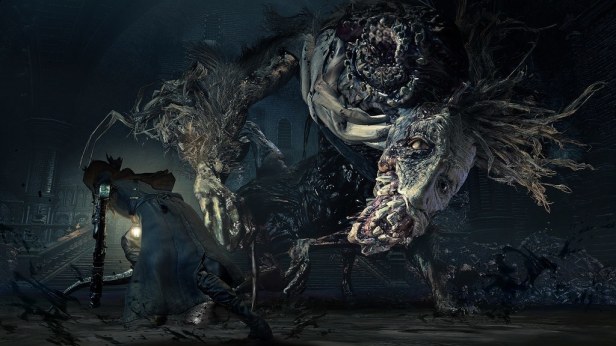Ever since they first began making sense of the world they inhabited and their very purpose on it, humans have been exposed to various tribulations, both internal and external, that have cast a shadow on both the psyche of the individual and civilization as a whole. Such a shadow, born out of literary and cultural heritages that have shaped our view of nature and technology, served as an ideal breeding ground for the manifestations of humankind’s vices and wrongdoings, portentous beings known as monsters. From paintings to movies, witnessing a monster from the passive eyes of the participant made for skin-crawling experiences that defined different societies and the zeitgeist of past historical periods. Actively encountering freaks ourselves, however, would prove leaps and bounds more harrowing, and games serve as an immaculate gateway into the fantasy of directly confronting them.

Popularized in titles that have made up video games’ early history such as Pac-Man (1980) and Splatterhouse (1988), virtual monsters have acted as colorful or morbid foes whose formidability and defiance of the common laws of nature encouraged players to adopt evasive strategies or offensive maneuvers that put a heavier emphasis on the participant’s wits compared to more wonted forms of hostilities. Given the medium’s unique interactivity and the hefty reliance it placed on the gamer’s reflexes and understanding of the systemic rules, it made perfect sense for the developer to utilize the “monstrosity template” and craft an atmosphere that combined audiovisuals and mechanics in a way that tapped into the participant’s survival instincts. In layman’s terms, the designer sought to make the player feel like their onscreen avatar: fearful of what’s coming, but prepared to make the necessary moves and sacrifices to face nightmares come to life.
With each passing gaming generation and the expansion of gameplay styles, developers embraced up-to-the-minute engines and technology to conceive more frightening enemies that could force a change of tactics on the player’s part. From the Gatherers roaming Brennenburg Castle in Amnesia: The Dark Descent (2010) to the maturing monster classes in Evolve (2015), the amount of imagination one could have with concocting impressive fiends gradually seemed limitless. But for every foe that upends the gamer’s usual playstyle like in Shadow of the Colossus (2005), there can be a flurry of uninspired baddies that appear otherworldly, but don’t pose an unorthodox challenge that’d make them outstanding enough to be particularly unsettling and indelible (as is the case with many zombie and orc types, for example).

Monsters make for daunting game enemies whose aesthetics and behavior stand out from average baddies, but there’s more to a creature than just the level of fear they elicit. As wayward entities whose very unearthly nature and embodiment of human failings trigger a petrifying response in our minds, monstrosities represent a golden opportunity for game makers to harness the multifaceted and dynamic makeup of the medium, as well as the active systems that govern what the avatar and NPCs are (in)capable of. Such potential should not only depend on the designer’s understanding of what a monster is at its core, but also on the developer’s ability to identify ways to build the virtual space and mechanics so that they’re conducive to possibilities for atypical and thought-provoking encounters that have gamers scrambling for solutions while confronting their worst fears.
I shall expound my argument by listing six beneficial principles that can beget beasts that not only put players on edge, but also mesh well with video gaming’s dynamism and potential for narrative-mechanics synergy. For each guideline, I’m going to give you an example of a title that gets that particular aspect right.

DISCLAIMER: The tips that I’m sharing with you may or may not be compatible with every game depending on the designer’s philosophy and vision, but they serve as general tenets that can benefit the virtual experience when well-implemented.
1 – Weave unpredictability into the creature’s mindset to constantly keep players on their toes
When it comes to crafting game monsters, one of the first considerations a designer has to make is to ensure that the beast itself is mercurial enough to prevent the participant from easily exploiting it. This principle is highly crucial since the ultimate kind of fear is that of the unknown, which helps keep both the story and gameplay tense enough for the gamer to immerse themselves in the fantasy of being preyed upon by a menacing force. Attaining this emotional consistency requires the developer to consider the creature’s modus operandi, its level of intelligence and the environment in which it roams. These components (among others) will allow the enemy AI to not only leverage its repertoire of offensive/defensive tactics, but to also better assess the situation it’s in so that it can tweak its approach to cornering the avatar.
The Xenomorph in 2014’s Alien: Isolation is second-to-none when it comes to surprising and terrorizing the player at every turn. Over the course of Amanda Ripley’s trek on the claustrophobic Sevastopol, the gamer will come to terms with the idea that danger in the form of an animalistic extraterrestrial can strike at any moment. Due to the sundry vents and tight corridors that make up the space station, predicting where Amanda’s foe shall appear seems like a foolhardy endeavor, with echoing footsteps and the tracker’s inability to determine which level an NPC is on further adding to the tension. Combined with the emphasis on stealth and scarce supplies, Isolation never strays away from its goal of baking the fear of the unforeseeable in players’ mind via the alien.

Given that games rely on fair challenge and a degree of uncertainty to keep players thoroughly engaged, it only makes sense for the developer to do justice to the monster’s intrinsic ability to stupefy by doubling down on its preternatural properties. This requires the designer to carefully tweak the fiend’s attributes so that they are in harmony with what the participant is capable of doing in stressful situations and what the virtual space can provide in terms of routes and tactical permutations. Failure to do so can result in an experience that feels more frustrating than scary due to trial-and-error, while success can translate to genuinely harrowing moments that make the outcome unclear enough for the gamer to be willing to experiment, adding some much-needed dynamism to the battle of wits.
2 – Bake into the monstrosities apposite and unified symbolism that pertains to human frailties
Along with conveying terror through the fiend’s unpredictable patterns during gameplay, the developer must also take into account the possibility of using the creature’s traits as a means of evoking a message that speaks to the game’s characters and impart the title’s core motifs, which explore our species’ nature. Given the fact that monsters stood as symbols of human vulnerability and crises that predate written history and originate from sociocultural heritages, the designer’s use of beasts as game enemies grants a palpable avenue for delivering story and thematic details. This allows the developer to abide to the mantra of “show, don’t tell” by providing punchy context to the gameplay and sequences players go through in their fight for survival.
The Silent Hill series stands as a consummate example of this design philosophy, with the second installment (2001) depicting especially damning figures. Throughout James Sunderland’s time in the eponymous ghost town, gamers will be exposed to all sorts of humanoid anomalies that display peculiarly suggestive characteristics, with the Bubble Head Nurses and Mannequins serving as provocative examples. Being representations of the protagonist’s repressed sexuality and guilt, Silent Hill 2‘s foes communicate the title’s themes and backstory in a way that comes full circle once the participant realizes what the adventure was all about, resulting in a tale that’s tangibly touching thanks to the presentation of human woes via minatory entities.

As animate repositories of mankind’s convictions and vices whose demeanor terrorizes the individual and even mocks their natural inadequacies, monsters pose as tactile forms of social criticism that can supplement the title’s tale and make gamers think about the ultimate purpose of their journey. Care must be taken, however, if the developer aims to imbue their creatures with tons of pertinent meaning as a lack of subtlety and focus not only spoils the narrative, but also muddles the message the game seeks to convey. With a solid understanding of the emotional arc they want the player to witness and how the sundry monstrosities should be presented in accordance with the intended story/gameplay beats, the designer can generate potent commentary on the human condition that suffuses the experience with a thought-provoking through-line and opportunities for analysis.
3 – Leverage the monster’s distinctiveness via congruent level design
While the creature itself should be given a lot of attention and polish to make it suitably petrifying, consideration should also be granted to one of its most invaluable resources: its hunting grounds. As atmospheric tension can stem from both the space and its hostile inhabitants, the developer can maximize the experience’s fear factor by taking into the account the monster’s attributes and ingraining its capabilities into the level structure (and vice-versa). In addition to offering locales with sui generis twists and turns that highly encourage the gamer to evaluate their surroundings, this fiend-lair design synergy also begets numerous possibilities to ramp up the suspense and deliver inventive scenarios.
One title that leverages this principle to stellar effect while still making it enjoyable for players to traverse the game world is 2017’s Little Nightmares. In this puzzle-platformer, the gamer has to traverse the ambiguous “Maw” while confronting all sorts of unsettling creatures that reside in idiosyncratic abodes. From the uniquely vertical spaces that present tense opportunities for the long-armed Janitor to catch its prey, to the large banquets that provide hair-raising cat-and-mouse sequences with the Guests, Tarsier Studios’ horror fest makes swell use of genre conventions to make each area as distinctly inhospitable as the fiends that dwell in them, resulting in an extra dose of environmental storytelling that meshes seamlessly with the mechanics.

As mentioned in my narrative review of Thief: The Dark Project, environmental design can be smartly used to relay the inhabitant’s mindset and nature to the player, which is a philosophy that’s especially crucial for monsters as their extraordinary qualities can be conducive to atypical locales that challenge the gamer’s playstyle. This potential symbiosis means that the designer can get especially experimental with the tone and layout of the environments, which can even translate to pacing that cleverly toys with the participant’s anticipation of what may lurk around the corner. Not only can this create a stronger presentational identity for the title, it can also act as an effective deterrent against cookie-cutter level design that inspires the developer to make each area as memorable and quirky as its occupant(s), engendering an association between the two that will have players dread every step they take.
4 – Have the beast’s audiovisual and mental makeup serve a mechanical purpose for allowing the gamer to have a fighting chance
With the right blend of auditory cues and physical traits that contribute to its dicey demeanor, a monster can strike fear in the player’s senses and assert itself in and out of combat. But the communication of such features can also provide the participant with the means to study its daunting fiend and comprehend what makes it stronger and weaker than the average person. As monsters need plausibility to keep the story gripping and the gameplay engaging, the designer should produce the creature with flaws in mind so that the tug of war between the avatar and their opposition is maintained. By having the unnatural composition and comportment of the monstrosities act as potential gateways into their foibles and Achilles’ heel, the gamer can start treating them less like regular obstacles that require the most basic of strategies and more like threatening puzzles that must be solved on-the-fly, making players feel resourceful and smart rather than lucky.
Visceral Games’ Dead Space trilogy presents a clear illustration of the narrative-mechanics synergy seen in the enemies’ design. As systems engineer Isaac Clarke, players have access to (un)conventional tools that can be effective at exploiting the Necromorphs’ instinctive proclivity for multi-limb sprouting. Thanks to the numerous variants on offer, every alien’s physique invites both dread and creative opportunities for dispatching them with precision. Not only does this put a spin on the shooter and horror genres’ combat templates, it also invites the participant to audiovisually ascertain the best way to take on a particular foe, making the art of planning one’s attack just as rewarding as executing it and adding a layer of depth to the monsters themselves.

With the presence of idiosyncratic enemy properties comes juicy possibilities for dispatching one’s foes inventively, and monsters act as immaculate conduits for unorthodox gameplay approaches. This is where the designer must maintain a balance between conspicuousness and subtlety to avoid insulting the gamer’s intelligence or discombobulating them during distressing engagements that can work against the tension that’s supposed to be built up. By understanding the monstrosities’ faculties and the manners in which they instinctively make them known in front of the avatar, the developer can turn encounters into openings for simultaneous observation and retaliation on the player’s part. All of this adds a layer of careful planning to the act of evading or subduing enemies that prevents gameplay from feeling stale.
5 – Conceive the creature in a way that promotes strategic resource management
One of the main edges a monster has over a typical game baddie from a design standpoint is that its fearful qualities can be used to promote different means of problem-solving to the player, more specifically with regards to resources. Due to the fiend’s aforementioned unpredictability, the participant shouldn’t expect their necessities to be fruitfully expended in a straightforward fashion since that’d take away from the terror of facing the creature. Instead, the developer must craft mechanics around the daunting enemies that enable the gamer to conscientiously allocate their equipment in preparation for any encounter with the horrors they’ll come across. As a result, the player must embody the idea that the monstrosities will use any managemental slip-ups to their advantage while the avatar is gathering and utilizing their items.
2002’s The Thing serves as a noteworthy take on the idea of conserving precious supplies in the face of unpredictable abominations. Based on the 1982 horror flick of the same name, this third-person shooter cleverly bakes into its gameplay the titular beast’s exploitation of the survivors’ “stronger together” stratagem by incorporating a fear/trust system that forces players to make conscious decisions in terms of convincing “friendly” NPCs that their avatar isn’t a Thing. From performing discriminating blood tests to sharing powerful equipment, the gamer potentially puts themselves at risk of being tricked by the assimilating monster, which allows the game to maintain a consistent level of uneasiness that’ll keep the player on edge and compel them to be more careful with their actions as they strive to survive in the Antarctic setting.

Because monsters are, by definition, defiant toward the order of nature, they should similarly go against the conventions of being dealt with through unrelenting force, meaning that it behooves the developer to organize the title’s systems and mechanics around the thrifty use of the avatar’s resources. When conceiving the foe’s advantages and weaknesses, the designer must also empathetically consider how the player character and their allies (if they have any) would behave when they’re in such a pickle. By doing so, the experience can demonstrate novel gameplay possibilities that give an exclusive identity to the beasts and the gamer’s brainstorming of ideas for warding off their enemies, making the gathering/dispensing of resources that much more consequential over the course of the avatar’s adventure.
6 – Inject some backstory into the monster to make it compelling both as a creature and a distinct character
For all their blood-curdling features and equally uneasy behavior, monsters can still demonstrate a degree of character depth that makes the gamer think about the threats they’re facing and how they came to be. While seemingly incongruous for a life form of varying unearthliness to have a background suggesting human-like concepts and livelihoods, the developer can treat the abnormalities as beings whose past showcased tribulations and woes somewhat akin to our species’, the same ones that were behind the creation of the very first beasts in history. By imbuing the figure with a coherent motive and backstory, players will believe in their foes’ agency, making the experience more engrossing and unlocking the most primal fear of all — the fear that we, ourselves, could turn into monsters.
From Software’s Bloodborne manages to make its monstrosities both unsettling and interesting to learn about through its incorporation of the above principle. Like the Souls series, this 2015 RPG leverages its lore-based storytelling to envelop the world with an aura of mystery, allowing the baleful entities roaming Yharnam to benefit from some fetching backstory that contextualizes their raison d’être. Whether it’s understanding Ludwig’s solemn past or uncovering the relationship between the Great Ones and Kin, Bloodborne reminds the participant that monsters can display somewhat human traits (physically, sociologically and psychologically) and/or patterns that tap into our collective unconscious and turn the horrors into beings whose commonalities leave players thinking after putting the creatures out of their misery.

Considering that the likes of King Kong and Frankenstein’s Monster have successfully inspired the pity and empathy of the participant along with terror, adding a dash of humanity to game fiends can work in the experience’s favor when balanced properly with the gameplay. By juxtaposing the discomposing facets of the beast with details that suggest some claim to victimhood of its own, the player can perceive its inhuman adversaries as organisms with eerie parallels to humankind. This in turn produces a feeling of existential fear that puts into perspective the gamer’s actions and their species’ capacity for evil. As a result of this damning context, the sense of ambiguity seen in supernatural and/or horror works can upend the idea of heroic empowerment in games and turn the participant’s encounters with abominations into a struggle to preserve not just the avatar’s life (as with most virtual baddies), but also their integrity as conscious individuals.
As filmmaker Guillermo del Toro once stated, monsters represent the patron saints of human imperfection. In game development, such a thought can translate to fiends that not only toy with the player’s psyche, but also challenge their naturally limited cognition in a way regular enemies are incapable of. By treating monstrosities as unearthly entities that can take advantage of the space and the avatar’s vulnerabilities to engender bone-chilling engagements, the designer can go beyond what’s expected from a hostile NPC and turn anything that’s part of or influenced by the abominations into distinct obstacles that need to be overcome, be it their audiovisual composition, abode or the systems/mechanics that govern the gamer’s resource management and offensive/defensive skills. With the guidelines I laid out, developers can craft menacing foes that put both the player’s wits and moral compass to the test, resulting in an experience that will open their eyes to a unique brand of primal terror.

TAILPIECE: Normally I end my articles with the usual “Let me know what you think…” paragraph and links to my contact information, but I’d like to take the time to quickly share a couple of things that led me to make this post in the first place.
Firstly, this piece likely wouldn’t have materialized had it not been for my reading of Philip Athans‘s Writing Monsters. On top of being a lean and mean guide on the art of crafting convincing creatures that’s filled with stellar examples, the book also includes a highly helpful monster creation form that I myself have used extensively for my endeavors… which brings me to my second point.
Over the course of 2018, I’ve been hard at work on multiple monster sheets and illustrations, and even a full-blown game design document for a survival horror title that I’ve been envisioning for a long time. Given my project’s scope, I’ll discuss the conceptualization process in a future post, but here’s a quick glance at what I concocted!


The reason I’m mentioning all of this is because I want to demonstrate how your imagination as a creative talent can be ignited by the simplest of decisions (in my case, reading Athans’s book), so perhaps this tailpiece will serve as a genuine reminder to hit the books and get inspired for your topic of choice! You may thank me later.
Let me know what you think of my article in the comments section, and feel free to ask me questions! I’ll do my best to get back to you as promptly as possible.
Personal blog: https://michelsabbagh.wordpress.com/
Twitter: https://twitter.com/Watfen64
LinkedIn: https://ca.linkedin.com/in/sabbaghmichel
Facebook: https://www.facebook.com/Michformer
Email: michelsabbagh2003@msn.com


Great read and accessible introduction to the creation of monsters. Really appreciate the way you highlight the importance of utilising design, writing, and mechanics in combination to achieve gripping monster encounters. Too often one sees incongruence between the three…
Look forward to following your own monster development!
LikeLiked by 1 person